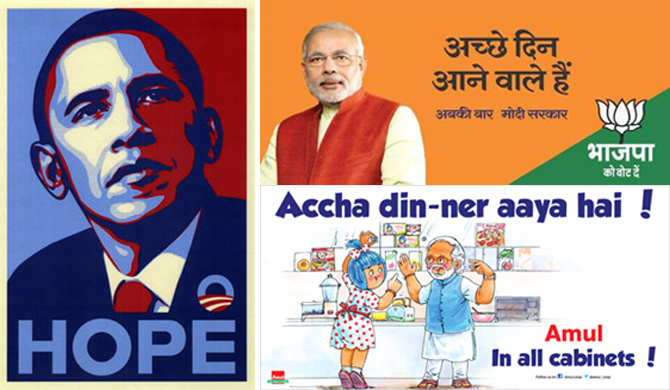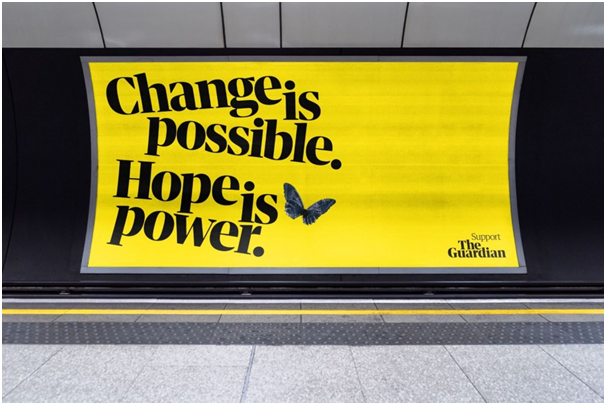Optimism is the secret sauce of communication, or is it?
Q. Know what’s common between acche din, just do it, all is well, apna time aayega, and dudho-nahao-puto-phalo?
A. Hope!
Different worlds they may belong to, what binds all of these iconic lines is the fact that they all centre around the idea of letting loose a whiff of ‘hope’ in the air.
Remember the maha-successful ‘Ache din aane waale hain’ campaign of the BJP party that contributed big in the party’s clean sweep in 2014 national elections? The campaign served one purpose – to give to the voters a ray of hope ‘to transform India’. “The entire thinking was based on research that BJP had done on how people were looking forward to better days.” said Piyush Pandey*, Executive Chairman, India & Chief Creative Officer- Worldwide, O&M. Much like Barack Obama’s 2008 presidential campaign “Hope & Change” that helped him win the presidency with nearly 53% of the popular vote.

Politics aside, there’s another cult institution that feeds into the power of hope – religion. When our godmen ask us to keep ‘Shraddha & Saburi’, when they give us a consolation in “bhagwaan jo karta hai, acche ke liye karta hai”, when they shower us with fancy phrases be it Tathastu, Amen or Ameen — they are actually motivating the devotees to look up to the future, no matter how harsh one’s current situation is.
Pravachans are nothing but pep talks on hope. Prasadams are nothing but sugar-laden happy pills. The philosophy of karma is noth but a white paper on being hopeful of getting what you deserve. Prayers, across religions, are a rallying cry for a better future.
The message is clear. Hold on to hope. Nice & tight. And you’ll make it, alright.
Much like politics and religions, the world of advertising is no different. Whatever the product, whatever the brand, ad gurus have always known that ‘hope’ is the single most selling proposition.
Products are designed. Strategies are chalked out. Campaigns are run. To spark hope. “Humari cream istamal karoge toj apki twacha hi nahi, but future bhi nikhar jaayega”, “Watch out for our watches, they’ll let the world know that your time has arrived”, “Chaar bottle of our beverages can bring in happiness into your life”.
Most happening ideas hover around hope. Generic as hell it maybe, but hope sells like hot cakes.

The use of hope vs fear in Health Advertisements is common place as well. Closer home when the pandemic struck
the whole of humanity, all of us latched onto hope. “When covid is over … ” not just remained a conversation starter for many, but became a full-blown meme fest. We feared, we stayed home, we turned to nostalgia, we laughed and we chased silver linings in pursuit of a happy ending.
View this post on Instagram
View this post on Instagram

The more we distanced ourselves for one another, the tighter we hugged on to hope.
Brands helped us to hope as well. As consumers struggled to adopt the ‘new normal’ post lockdown, brand communications sold the power of optimism more than the product itself.
Coca Cola’s ‘Open Like Never Before’ campaign encouraged people to pick up pieces, start over again and bounce back post lockdown in a renewed spirit. Castrol’s Keep Moving Ahead video encouraged the audience to welcome the new normal. The Colgate TVC gave us another story of optimism “Celebrate a new freedom and begin again with a smile” with the metaphorical narrative normalising the concept of remarriage. Through their ad campaigns, the focus was on instilling positivity, normalcy and resilience.
Positivity is all good, I get it. But, how much hope is too much hope? Is too much hope, a thing really? Can too much hope borderline at delusional thinking? Does clinging to hope takes you away from ground reality? Different strokes from different folks, I believe.
So, here’s to partaking hope in perfect proportions.
https://www.business-standard.com/article/management/tale-of-two-ad-campaigns-114051901164_1.html
